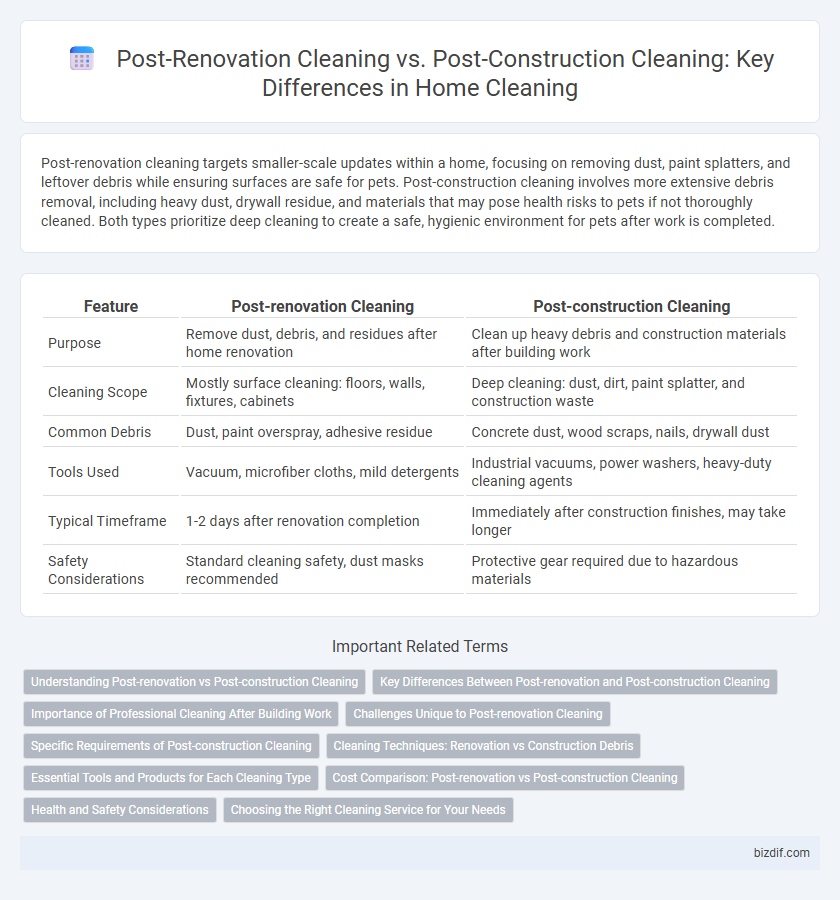Post-renovation cleaning targets smaller-scale updates within a home, focusing on removing dust, paint splatters, and leftover debris while ensuring surfaces are safe for pets. Post-construction cleaning involves more extensive debris removal, including heavy dust, drywall residue, and materials that may pose health risks to pets if not thoroughly cleaned. Both types prioritize deep cleaning to create a safe, hygienic environment for pets after work is completed.
Table of Comparison
| Feature | Post-renovation Cleaning | Post-construction Cleaning |
|---|---|---|
| Purpose | Remove dust, debris, and residues after home renovation | Clean up heavy debris and construction materials after building work |
| Cleaning Scope | Mostly surface cleaning: floors, walls, fixtures, cabinets | Deep cleaning: dust, dirt, paint splatter, and construction waste |
| Common Debris | Dust, paint overspray, adhesive residue | Concrete dust, wood scraps, nails, drywall dust |
| Tools Used | Vacuum, microfiber cloths, mild detergents | Industrial vacuums, power washers, heavy-duty cleaning agents |
| Typical Timeframe | 1-2 days after renovation completion | Immediately after construction finishes, may take longer |
| Safety Considerations | Standard cleaning safety, dust masks recommended | Protective gear required due to hazardous materials |
Understanding Post-renovation vs Post-construction Cleaning
Post-renovation cleaning targets removal of dust, paint splatters, and leftover materials after interior updates or remodeling, ensuring surfaces, fixtures, and appliances are spotless. Post-construction cleaning involves heavy-duty debris disposal, dust elimination from structural elements, and thorough cleaning of windows, floors, and HVAC systems following new builds or extensive structural work. Both services require specialized tools and techniques but differ in scope due to varying debris types and cleaning intensity.
Key Differences Between Post-renovation and Post-construction Cleaning
Post-renovation cleaning focuses on removing dust, paint splatters, and debris resulting from interior updates, such as new flooring or drywall installation. Post-construction cleaning involves a more comprehensive cleanup, tackling heavy debris, leftover building materials, and deep dust removal from both interior and exterior sites. The key differences lie in the scale of debris, with post-construction cleaning requiring industrial-grade equipment, while post-renovation cleaning targets finer dust and surface residues.
Importance of Professional Cleaning After Building Work
Professional cleaning after building work is essential to remove hazardous dust, debris, and residues left from renovations or constructions, ensuring a safe and healthy living environment. Post-renovation cleaning targets fine dust, paint splatters, and surface smudges that standard cleaning misses, while post-construction cleaning involves clearing larger debris, drywall dust, and construction waste. Expert cleaning services use specialized equipment and techniques to restore hygiene and aesthetic appeal, preventing potential respiratory issues and damage to interiors.
Challenges Unique to Post-renovation Cleaning
Post-renovation cleaning involves removing fine dust, paint splatters, and adhesive residues that standard cleaning often misses, posing unique challenges for thorough surface restoration. Unlike post-construction cleaning, which primarily addresses large debris and leftover materials, post-renovation cleaning requires meticulous attention to delicate fixtures, newly installed flooring, and trim to avoid damage. Specialized tools and cleaning agents are essential to restore the property's appearance and ensure a healthy indoor environment after renovation projects.
Specific Requirements of Post-construction Cleaning
Post-construction cleaning demands specialized attention to remove hazardous debris, dust, and fine particles left by construction activities, ensuring safety and compliance with building codes. This process requires industrial-grade equipment and heavy-duty cleaning agents to tackle cement dust, paint splatters, and adhesive residues. Unlike post-renovation cleaning, it focuses on site-specific hazards, structural dust, and waste management to prepare the space for occupation or further interior finishing.
Cleaning Techniques: Renovation vs Construction Debris
Post-renovation cleaning targets fine dust, paint splatters, and adhesive residues using microfiber cloths, vacuums with HEPA filters, and gentle scrubbing techniques to preserve delicate surfaces. Post-construction cleaning demands heavy-duty methods such as industrial vacuums, debris removal tools, and strong solvents to tackle coarse materials like drywall dust, nails, and cement residues. Effective post-renovation cleaning emphasizes precision and surface protection, while post-construction cleaning prioritizes thorough removal of bulky and hazardous debris.
Essential Tools and Products for Each Cleaning Type
Post-renovation cleaning requires heavy-duty vacuums, microfiber cloths, and multi-surface cleaners to effectively remove dust, paint splatters, and adhesive residues. Post-construction cleaning demands industrial-grade tools such as HEPA-filter vacuums, heavy-duty scrapers, and specialized degreasers to handle cement dust, drywall debris, and stubborn stains. Both cleaning types benefit from protective gear like gloves and masks to ensure safety during thorough cleaning processes.
Cost Comparison: Post-renovation vs Post-construction Cleaning
Post-renovation cleaning generally incurs lower costs than post-construction cleaning due to the smaller scale and less intensive debris removal required after remodeling or updating a space. Post-construction cleaning involves extensive dust, heavy waste, and hazardous materials, increasing labor time and the need for specialized equipment, which drives up the price. Homeowners should expect post-renovation cleaning to range between $200 and $600, while post-construction cleaning can cost $500 to over $1,500 depending on property size and project complexity.
Health and Safety Considerations
Post-renovation cleaning targets dust, paint fumes, and chemical residues that pose respiratory and skin irritation risks, requiring thorough ventilation and use of non-toxic cleaning agents to ensure indoor air quality. Post-construction cleaning involves removing heavy debris, sharp objects, and hazardous materials like nails and asbestos, necessitating protective gear and strict disposal protocols to prevent injuries and contamination. Both processes prioritize eliminating airborne particles and harmful substances to protect occupants' health and maintain a safe living environment.
Choosing the Right Cleaning Service for Your Needs
Post-renovation cleaning targets detailed removal of dust, paint residues, and debris left by home improvement projects, ensuring surfaces and fixtures are spotless. Post-construction cleaning involves a broader scope, eliminating heavy dust, leftover materials, and construction waste from new builds or major structural work. Selecting the right cleaning service depends on the specific type of project completed, the level of dirt and debris present, and whether fine detail or extensive debris removal is required for a safe, livable space.
Post-renovation Cleaning vs Post-construction Cleaning Infographic

 bizdif.com
bizdif.com